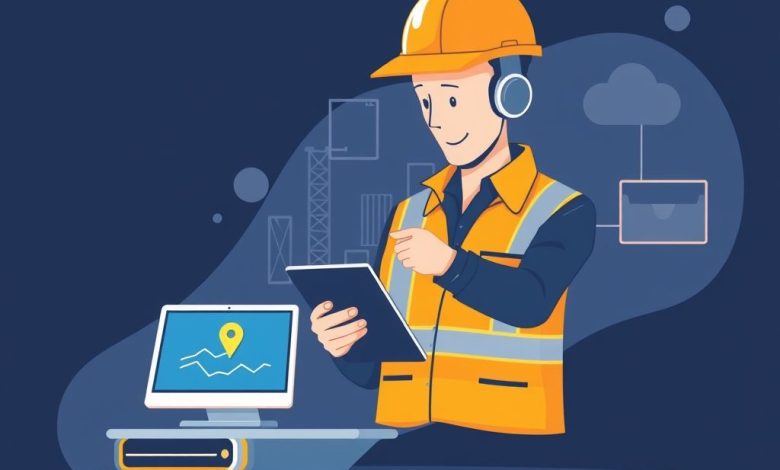Field Service Management with Technician Location Check-In Enhancing Operational Efficiency and Customer Satisfaction

Introduction
Field Service Management (FSM) is a critical component of modern business operations, particularly in industries such as HVAC, electrical work, plumbing, and home maintenance. The core objective of FSM is to efficiently manage and coordinate field-based services while ensuring high-quality customer satisfaction. One crucial aspect of effective FSM is the ability to track technician location check-ins, which plays a vital role in optimizing mobile workforce performance.
What is Field Service Management?
Field Service Management refers to the processes and systems used to manage and coordinate field-based services. It encompasses various aspects of service delivery, including scheduling, dispatching, resource allocation, and customer communication. In today’s digital age, FSM has evolved significantly, incorporating advanced technologies such as mobile applications, cloud computing, and data analytics.
Key Components of Field Service Management
- Scheduling and Dispatching
- Efficiently allocating resources based on job priority and technician availability
- Optimizing routes to minimize travel time and reduce costs
2. Resource Allocation
- Managing inventory levels and equipment availability
- Assigning appropriate technicians to specific jobs based on skill sets and experience
3. Customer Communication
- Providing timely updates on appointment status and estimated arrival times
- Handling customer inquiries and resolving issues promptly
4. Performance Monitoring
- Tracking key metrics such as first-time fix rates, response times, and customer satisfaction scores
- Identifying areas for improvement and implementing corrective measures
The Importance of Technician Location Check-In
Technician location check-in is a fundamental feature of modern Field Service Management systems. This functionality allows companies to monitor the real-time location of their field technicians, providing numerous benefits:
- Improved Dispatch Accuracy
- Ensuring the closest available technician is sent to each job
- Reducing response times and improving overall service efficiency
2. Enhanced Customer Experience
- Providing accurate estimated arrival times to customers
- Allowing customers to track the progress of their service appointment
3. Increased Productivity
- Optimizing routes based on real-time location data
- Minimizing unnecessary travel time and reducing fuel consumption
4. Better Resource Allocation
- Identifying areas with high technician concentration for efficient resource distribution
- Avoiding over-allocation in specific regions
How Technician Location Check-In Works
Technician location check-in typically involves the following steps:
- Mobile Application Deployment
- Installing a dedicated mobile app on technicians' smartphones or tablets
- Ensuring seamless integration with the FSM system
2. Real-time Tracking
- Utilizing GPS technology to monitor technician locations
- Updating location data in real-time as technicians move between jobs
3. Automated Check-ins
- Setting up predefined check-in points along routes
- Automatically recording arrival times at each job site
4. Data Integration
- Syncing location data with the central FSM system
- Updating dispatcher views with real-time information
Benefits of Implementing Technician Location Check-In
Implementing a robust technician location check-in system can significantly enhance field service operations:
- Improved Efficiency
- Optimized scheduling and dispatching processes
- Reduced travel time and associated costs
2. Enhanced Customer Satisfaction
- Accurate estimated arrival times leading to higher customer satisfaction scores
- Increased transparency throughout the service process
3. Data-driven Decision Making
- Access to valuable insights on technician performance and route optimization
- Ability to identify trends and make informed strategic decisions
4. Competitive Advantage
- Differentiation through superior service delivery and responsiveness
- Attracting and retaining customers in competitive markets
Challenges in Implementing Technician Location Check-In
While the benefits of technician location check-in are significant, implementing such a system comes with its own set of challenges:
- Privacy Concerns
- Addressing potential privacy issues related to tracking employee movements
- Ensuring compliance with relevant data protection regulations
2. Technology Infrastructure
- Ensuring reliable internet connectivity for mobile devices
- Managing battery life of mobile devices during extended working hours
3. User Adoption
- Training technicians to effectively utilize the mobile application
- Encouraging consistent check-ins and adherence to protocols
4. Cost Implications
- Initial investment in hardware and software solutions
- Ongoing maintenance and support requirements
Best Practices for Effective Technician Location Check-In
To maximize the benefits of technician location check-in, consider the following best practices:
- Regular System Updates
- Keeping the mobile application and backend systems updated
- Ensuring compatibility with latest operating systems and devices
2. Customizable Alerts
- Setting up notifications for late arrivals or unexpected delays
- Allowing dispatchers to proactively manage potential issues
3. Integration with Other Systems
- Seamless integration with CRM, accounting, and other business systems
- Ensuring a holistic view of service operations across departments
4. Continuous Monitoring and Improvement
- Regularly reviewing check-in data for insights
- Implementing feedback mechanisms to enhance the system over time
Conclusion
Field Service Management with Technician Location Check-In represents a powerful combination of technology and operational excellence. By leveraging advanced tracking capabilities, companies can significantly improve their field service operations, leading to increased efficiency, enhanced customer satisfaction, and a competitive edge in the market.
As the field service industry continues to evolve, the importance of real-time location tracking will only grow. Companies that embrace this technology early will be well-positioned to capitalize on its benefits and maintain their position as leaders in their respective markets.
By implementing a robust FSM system with integrated technician location check-in capabilities, businesses can transform their field service operations into a model of efficiency, productivity, and customer-centricity. As we move forward in this digital age, it’s clear that Field Service Management with Technician Location Check-In will play an increasingly crucial role in determining the success of companies operating in field-based industries.



